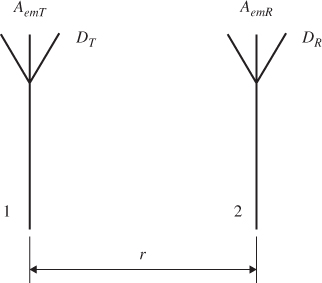Appendix A
Effective Aperture and Directivity1
The effective aperture of an antenna is uniquely related to its directivity. By using the directivity and effective aperture of a short dipole, which are relatively easily calculated, a general interrelation between effective aperture and directivity, valid for any antenna, will be derived.
Consider the two-antenna communication system of Figure A.1. System 1 can be the transmitter, while system 2 is the receiver, or the other way around. The antennas are displaced a distance r apart and are assumed to be lined up with respect to polarization and directivity. The directivity of antenna 1 is DT, its maximum effective aperture is AemT. Directivity and maximum effective area of antenna 2 are, respectively, DR and AemR. We start by considering the first option: antenna 1 is transmitting and antenna 2 is receiving.
Figure A.1 Two-antenna communication system. The antennas are displaced a distance r and are assumed to be lined up with respect to polarization and directivity. The directivity of antenna 1 is DT, its effective aperture is AemT. Directivity and effective area of antenna 2 are, respectively, DR and AemR.

The total radiated power by antenna 1 is PT. If antenna 1 were an isotropic radiator, the power density, S0, at distance r from antenna 1 would be
A.1
Due to the directive properties of antenna 1, the actual power density, ...

